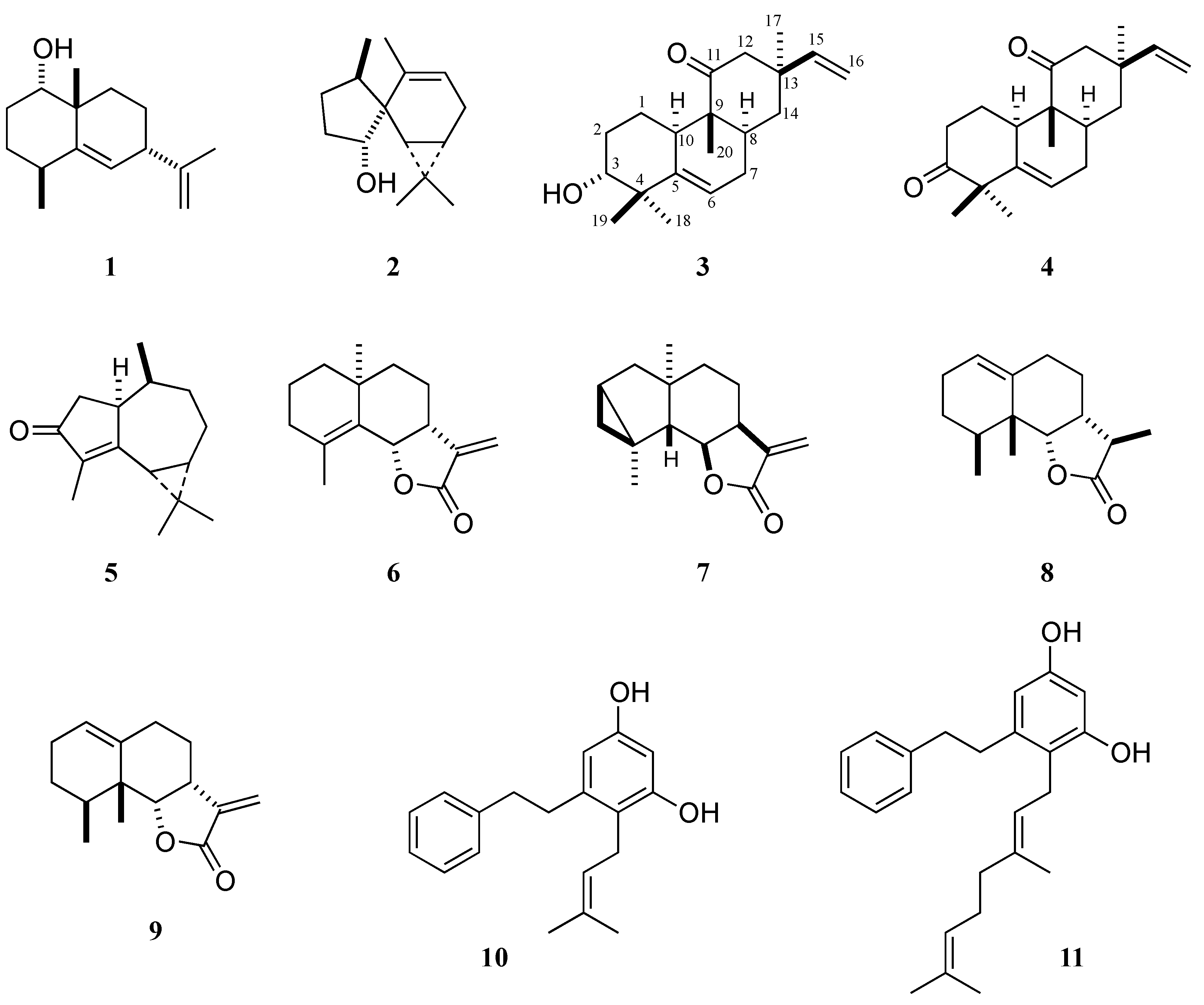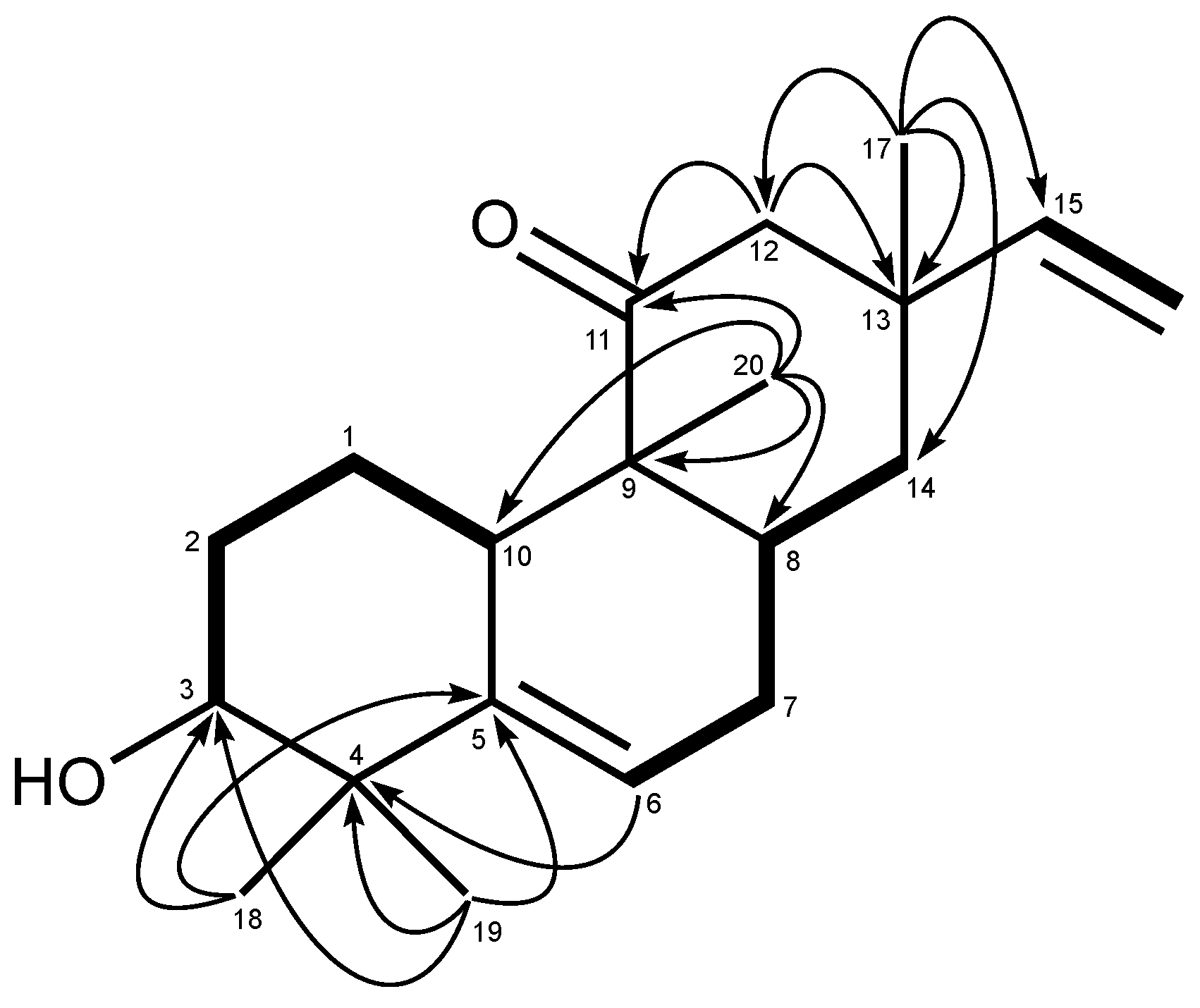Terpenoids and Bibenzyls from Three Argentine Liverworts
Abstract
:1. Introduction

2. Results and Discussion
| H | H | ||
|---|---|---|---|
| 1 | 1.01 m | 14 | 1.36 dd (10.2, 2.5) α |
| 1.97 m | 1.76 m β | ||
| 2 | 1.69 m | 15 | 5.83 dd (17.3, 10.7) |
| 1.78 m | |||
| 3 | 3.23 dd (11.5, 4.7)b | 16 | 4.94 dd (10.7, 0.8) |
| 4.96 dd (17.3, 0.8) | |||
| 6 | 5.56 d (6.3) | 17 | 0.97 s |
| 7 | 1.87 m | 18 | 0.99 s |
| 1.98 m | |||
| 8 | 1.77 m | 19 | 1.15 s |
| 10 | 2.72 m | 20 | 0.98 s |
| 12 | 1.95 dd (12.6, 2.5) α | ||
| 2.73 d (12.6) β |
| C | 3 | 4 [6] | C | 3 | 4 [6] |
|---|---|---|---|---|---|
| 1 | 25.3 | 25.2 | 11 | 214.7 | 214.4 |
| 2 | 30.3 | 37.8 | 12 | 48.4 | 48.5 |
| 3 | 77.2 | 214.6 | 13 | 41.6 | 41.6 |
| 4 | 42.1 | 51.0 | 14 | 38.4 | 38.4 |
| 5 | 145.5 | 144.2 | 15 | 147.9 | 147.7 |
| 6 | 117.0 | 118.2 | 16 | 110.2 | 110.4 |
| 7 | 28.9 | 29.0 | 17 | 23.5 | 23.5 |
| 8 | 38.3 | 38.2 | 18 | 21.4 | 22.7 |
| 9 | 48.9 | 49.4 | 19 | 24.4 | 29.5 |
| 10 | 37.9 | 38.6 | 20 | 12.7 | 12.0 |


3. Experimental
3.1. General
3.2. Extraction and Isolation
4. Conclusions
Acknowledgements
References and Notes
- Asakawa, Y. Chemical constituents of the Hepaticae. In Progress in the Chemistry of Organic Natural Products; Herz, W., Grisebach, H., Kirby, G.W., Eds.; Springer-Verlag: Wien, Austria, 1982; Volume 42, pp. 1–269. [Google Scholar]
- Asakawa, Y. Chemical constituents of the Bryophytes. In Progress in the Chemistry of Organic Natural Products; Herz, W., Kirby, G.W., Moore, R.E., Steglich, W., Tamm, Ch., Eds.; Springer-Verlag: Wien, Austria, 1995; Volume 65, pp. 1–618. [Google Scholar]
- Asakawa, Y.; Toyota, M.; Nagashima, F.; Hashimoto, T. Chemical constituents of selected Japanese and New Zealand liverworts. Nat. Prod. Commun. 2008, 3, 289–300. [Google Scholar]
- Nagashima, F.; Kuba, Y.; Ogata, A.; Asakawa, Y. Sesqui- and diterpenoids from three New Zealand liverworts Bazzania novae-zelandiae, Gackstroemia sp. and Dendromastigophora sp. Nat. Prod. Res. 2010, 24, 68–75. [Google Scholar] [CrossRef]
- Matsuo, A.; Nakayama, M.; Sato, S.; Nakamoto, T.; Uto, S.; Hayashi, S. (−)-Maalioxide and (+)-cyclocolorenone, enantiomeric sesquiterpenoids from the liverwort, Plagiochila acanthophylla subsp. japonica. Experientia 1974, 30, 321–322. [Google Scholar]
- Feld, H.; Zapp, J.; Becker, H. Secondary metabolites from the liverwort Tylimanthus renifolius. Phytochemistry 2003, 64, 1335–1340. [Google Scholar] [CrossRef]
- Bardón, A.; Mitre, G.B.; Kamiya, N.; Toyota, M.; Asakawa, Y. Eremophilanolides and other constituents from the Argentine liverwort Frullania brasiliensis. Phytochemistry 2002, 59, 205–213. [Google Scholar]
- Asakawa, Y.; Muller, J.-C.; Ourisson, G.; Foussereau, J.; Ducombs, G. Nouvelles lactones sesquiterpéniques de Frullania (Hépaticae). Isolement, structures, propriétés allergisantes. Bull. Soc. Chim. France 1976, 1465–1466.
- Tori, M.; Miyazaki, N.; Kondo, K.; Taira, Z.; Asakawa, Y. Nepalensolide A, Novel sesquiterpene lactone from the liverwort Frullania nepalensis. Compound breaking the Samek rule. A study by NOE and X-ray. Chem. Lett. 1990, 2115–2116. [Google Scholar]
- Asakawa, Y.; Toyota, M.; Takemoto, T. Seven bibenzyls and a dihydrochalcone from Radula variabilis. Phytochemistry 1978, 17, 2005–2010. [Google Scholar] [CrossRef]
- Crombie, L.W.; Crombie, W.M.L.; Firth, D.F. Synthesis of bibenzyl cannabinoids, hybrids of two biogenetic series found in Cannabis sativa. J. Chem. Soc. Perkin Trans. 1 1988, 1263–1270. [Google Scholar]
- Asakawa, Y.; Kondo, K.; Tori, M.; Hashimoto, T.; Ogawa, S. Prenyl bibenzyls from the liverwort Radula kojana. Phytochemistry 1991, 30, 219–234. [Google Scholar] [CrossRef]
- Beyer, J.; Becker, H.; Toyota, M.; Asakawa, Y. Diterpenoids with a novel skeleton from the liverwort Anastrophyllum minutum. Phytochemistry 1987, 26, 1085–1089. [Google Scholar] [CrossRef]
- Zapp, J.; Burkhardt, G.; Becker, H. Sphenolobane and fusicoccane diterpenoids from the liverwort Anastrophyllum aurztum. Phytochemistry 1994, 37, 787–793. [Google Scholar] [CrossRef]
- Buchanan, M.S.; Connolly, J.D.; Rycroft, D.S. Sphenolobane diterpenoids from the liverwort Anastrophyllum donnianum. Phytochemistry 1996, 43, 1297–1301. [Google Scholar] [CrossRef]
- Asakawa, Y. Chemosystematics of Hepaticae. Phytochemistry 2004, 65, 623–669. [Google Scholar] [CrossRef]
- Kraut, L.; Mues, R.; Zinsmeister, H.D. Prenylated bibenzyl derivatives from Lethocolea glossophylla and Radula voluta. Phytochemistry 1997, 45, 1249–1255. [Google Scholar]
- Godin, P. A new spray reagent for paper chromatography of polyols and cetoses. Nature (London). 1954, 174, 134. [Google Scholar]
- Sample Availability: Samples of the compounds 5–10 are available from the authors.
© 2011 by the authors; licensee MDPI, Basel, Switzerland. This article is an open access article distributed under the terms and conditions of the Creative Commons Attribution license ( http://creativecommons.org/licenses/by/3.0/).
Share and Cite
Nagashima, F.; Asakawa, Y. Terpenoids and Bibenzyls from Three Argentine Liverworts. Molecules 2011, 16, 10471-10478. https://doi.org/10.3390/molecules161210471
Nagashima F, Asakawa Y. Terpenoids and Bibenzyls from Three Argentine Liverworts. Molecules. 2011; 16(12):10471-10478. https://doi.org/10.3390/molecules161210471
Chicago/Turabian StyleNagashima, Fumihiro, and Yoshinori Asakawa. 2011. "Terpenoids and Bibenzyls from Three Argentine Liverworts" Molecules 16, no. 12: 10471-10478. https://doi.org/10.3390/molecules161210471





